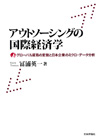Author's Introduction
An Empirical Study of New-New Trade Theory Using Micro Data on Outsourcing across National and Corporate Boundaries
Against the backdrop of the advancement and global diffusion of information and communications technology (ICT) as well as the rapid development of emerging economies led by China and India, the dynamics of global trade have changed significantly in recent years. In particular, we cannot afford to ignore the ongoing trend in which not only production processes—i.e., the manufacturing of parts and other intermediate goods and their assembly into final products—but also various service operations including those that used to be kept strictly in-house by Japanese companies are now being outsourced across national boundaries and even beyond corporate boundaries. In the area of international trade theory, studies of corporate behavior in globalization including offshore outsourcing have gathered momentum since the turn of the century and developed into a full-fledged branch of theory called "new-new trade theory." Using firm-level micro data collected in a proprietary survey conducted by the Research Institute of Economy, Trade and Industry (RIETI) as well as those obtained from statistics of the Ministry of Economy, Trade and Industry, this book examines Japanese companies' offshore outsourcing in a multi-dimensional and quantitative manner, defining their behavior by various measurements. It also provides a summary of findings in a series of pioneering empirical studies that tested the hypothesis of new-new trade theory on productivity, employment, and research and development. Throughout the book, I have provided explanations as to how each set of estimates fit into the overall picture so that those estimates together provide a bird's eye view of international trade theory as seen from the perspective of outsourcing. Where appropriate, I have referred to their relevance and implications to real-life situations. Also, while utilizing various kinds of data having high informational value, I used almost no mathematical expressions for explanation. As such, I would be glad if this book serves as a good reference not only for researchers in the field of international economics but also for those in the business community and economic policymakers.


